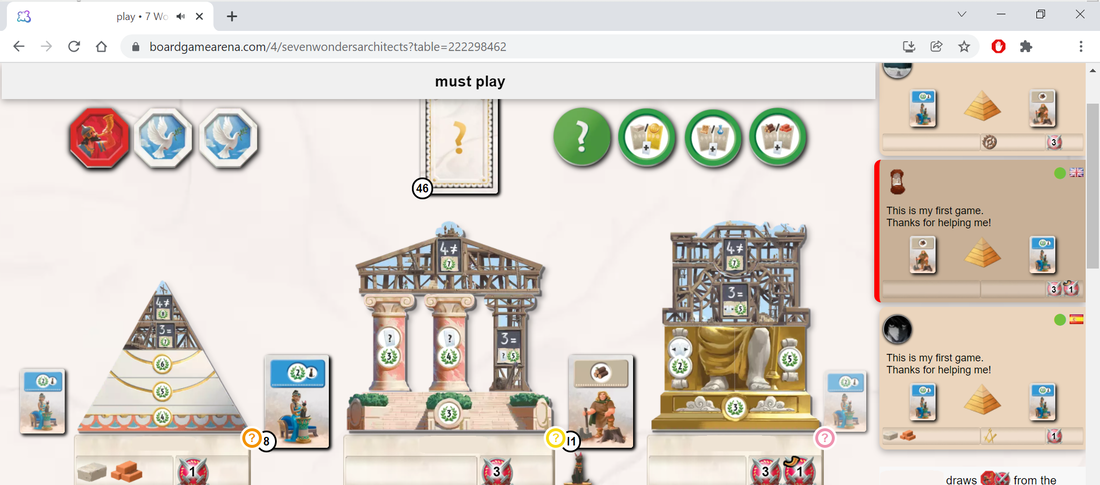|
8th December 2021 The next game of Wednesday afternoon gaming on Board Game Arena was 7 Wonders: Architects, which is essentially a 'spin-off' of and at least a little thematically similar to the titular 7 Wonders drafting game. Like it's ancestor, 7 Wonders: Architects is all about building one of the world's great wonders and no doubt dabbling in science, politics, religion and warfare while doing it. Caveat: We've only played this game digitally. What's in a game? In the physical game, when players are given/choose wonders to build, they are given that wonder's 'tray'' containing the relevant components for that wonder. However, none of this appears in the digital version
The artwork used throughout 7 Wonders: Architects is very similar to the original game which is both understandable and also pretty good, there's a nice variety of colourful illustration used throughout the cards. The same is true of the game's iconography, it looks identical to 7 Wonders and just like 7 Wonders, there's a lot of it. Most of it is pretty straightforward but players will invariably turn to the rules for an explanation from time-to-time. How's it play? Setup
On to play Play in 7 Wonders: Architects is pretty straightforward with the active player taking their turn before play proceeds to the player on their left.
Endgame The endgame is triggered at the end of any player's turn when the 5th tile for their wonder is flipped, thus completing it. Points come from a variety of sources. Wonder: Flipped tiles on wonders can provide points. Blue cards: All blue cards score victory points. Military victory tokens: These tokens contribute victory points. Progress tokens: These tokens may provide bonus victory points. Cat pawn: Whoever possess the cat pawn at the game end will earn a small amount of victory tokens. Points are tallied, highest score wins. Overall
It's quite impressive how the 7 Wonders: architects manages to distil so much of its parent game into this simpler product and I also like how the mechanic for flipping the wonder tiles works but I'm going to go ahead and say it; I'm pretty certain that I'm not the target audience for 7 Wonder: Architects. It feels a little like a 'entry-level' game that I found a little too shallow. When it comes to a players turn, they are fundamentally only given 3 choices. Take a face-up card from the left, take a face-up card from the right or take a face-down (Unless you have the cat pawn of course.) card from the central area and that's it. I suppose that it can force players to adapt, recognise and try to exploit the available cards to their fullest advantage but I feel that the game lacks the flexibility to see this through, there's no synergy between different card types and all of this makes it hard to create any sense of strategy during the game. In fact, it feels that strategy is reduced to pick a path to victory and hope that the cards which support that strategy appear. That meant it felt my choices had little significance beyond their immediate benefits. So, if I'm not the target audience for 7 Wonders: Architects, who is? Casual or light gamers? It strikes me that the rules have enough complexity to not be immediately accessible and the game's usage of iconography only compounds this - experienced gamers will be used to this, but casuals gamers, not so much. I Feel the game sort of straddles a strange middle ground between rules complexity and light gameplay which is the opposite of what you want and makes it less accessible to casual gamers and less compelling to more dedicated gamers.
0 Comments
Leave a Reply. |
AuthorI play, I paint. Archives
March 2024
Categories
All
|


 RSS Feed
RSS Feed
